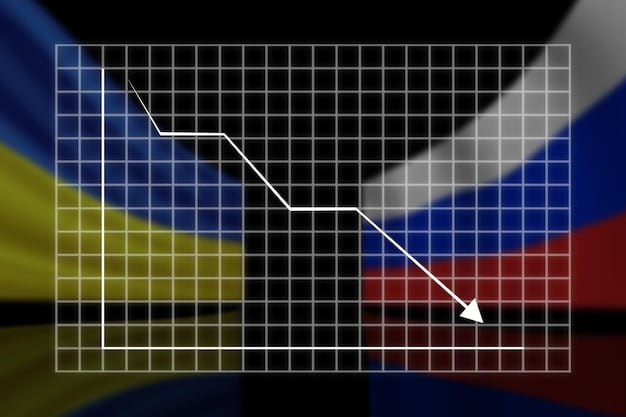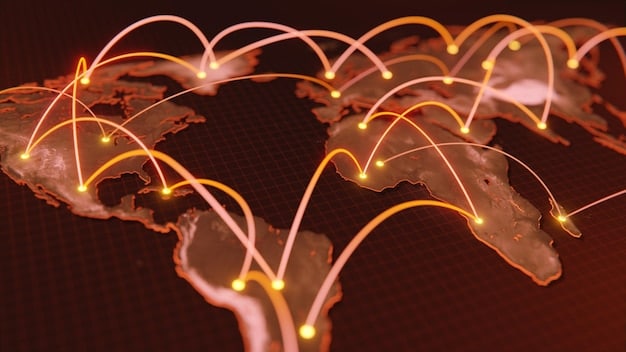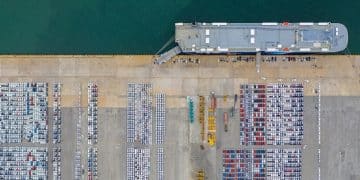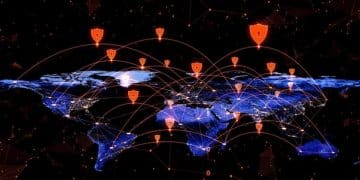US Import Tariffs: How a 12% Increase by 2025 Will Impact Your Business

The projected 12% increase in US import tariffs by 2025 will likely lead to higher costs for businesses, potentially impacting consumer prices, supply chains, and international trade relationships as companies navigate new financial pressures and strategic adjustments.
What does the projected 12% increase in US import tariffs by 2025 mean for your business? Understanding these potential economic shifts is crucial for strategic planning. Let’s delve into the likely impacts and what you can do to prepare.
Understanding the Impending Tariff Increase
The economic landscape is ever-shifting, and businesses need to stay ahead of the curve. Among the key factors that can significantly affect business operations are import tariffs. A projected 12% increase in US import tariffs by 2025 is poised to introduce substantial changes to how businesses operate and strategize.
Understanding what this increase means, where it comes from, and how it might play out is essential for making informed decisions.
What are Import Tariffs?
Import tariffs are taxes imposed on goods and services entering a country from abroad. These tariffs are designed to protect domestic industries, generate revenue, and influence international trade relations.
Why the Projected Increase?
Several factors might contribute to a projected tariff increase. These could include government policies aimed at reducing trade deficits, protecting specific industries, or responding to global trade imbalances.
- Geopolitical Tensions: Trade disputes and political instability can lead to increased tariffs.
- Economic Strategies: Governments might raise tariffs to encourage local production or counteract perceived unfair trade practices.
- Revenue Generation: Tariffs can serve as a source of government income.
Tariffs affect various sectors differently. Businesses that heavily rely on imported goods or materials face direct cost increases. Consumers may see higher prices on retail goods, and industries that export goods might experience retaliatory tariffs from other countries.

How the Tariff Hike Will Affect Your Supply Chain
A critical area impacted by increased import tariffs is the supply chain. Businesses often rely on international sources for materials and goods, and tariffs can disrupt these established networks.
Increased tariffs can cause bottlenecks, increase lead times, and add complexity to managing supply chains.
Direct Cost Increases
The most immediate effect of higher tariffs is the increase in the cost of imported goods. Businesses relying on these imports will see their expenses rise.
Supply Chain Disruptions
Higher costs can prompt businesses to seek alternative suppliers, potentially disrupting established supply chains. This search for cheaper options can lead to delays and quality concerns.
- Sourcing Challenges: Finding reliable and cost-effective alternatives can be time-consuming and resource-intensive.
- Quality Control: New suppliers might not meet the same quality standards, leading to product defects or customer dissatisfaction.
- Logistical Issues: Changes in supply chains can create logistical challenges in transportation and delivery.
Companies may need to reassess their existing supply chain models. Strategies such as diversifying suppliers, nearshoring (relocating operations to nearby countries), or investing in local production can mitigate the impact of tariffs.
Strategies to Navigate Rising Import Costs
Navigating the complexities of rising import costs requires a combination of strategic planning, operational adjustments, and financial foresight. Fortunately, many adaptive strategies are available for businesses to consider.
By taking proactive steps, businesses can minimize the negative effects of increased tariffs and even identify new opportunities for growth.
Cost Optimization
Businesses should focus on internal cost-cutting measures to offset the impact of higher tariffs. This could involve streamlining operations, improving efficiency, or negotiating better deals with suppliers.
Diversification of Sourcing
Instead of relying heavily on a single source for imports, businesses should diversify their supplier base. This reduces vulnerability to tariffs from specific countries or regions.

- Geographic Spread: Sourcing from multiple countries reduces reliance on any single region.
- Supplier Variety: Working with multiple suppliers reduces the risk of supply disruptions.
- Negotiating Power: A diversified base strengthens negotiation positions when dealing with suppliers.
Businesses should also consider passing on some of the cost increases to consumers. However, this must be done carefully to avoid pricing themselves out of the market.
The Impact on Consumer Prices and Demand
Tariffs, while initially levied on businesses, often trickle down to consumers in the form of higher prices. These price changes can influence consumer demand and purchasing behavior.
The extent and nature of these impacts depend on various factors, including the elasticity of demand for affected products and the competitive landscape.
Inflationary Pressures
Increased tariffs contribute to inflationary pressures, as businesses pass on higher import costs to consumers. This can reduce consumers’ purchasing power.
Shift in Consumer Behavior
Higher prices can cause consumers to shift their spending habits. They might opt for cheaper alternatives, reduce consumption, or delay purchases.
Many low-income households will suffer the higher consumer prices and businesses will lose revenue with the new tariffs.
Businesses need to monitor consumer behavior closely and adapt their strategies accordingly. This could involve adjusting pricing strategies, offering discounts, or introducing lower-cost product lines.
How Emerging Tech Can Help Mitigate Tariff Effects
Innovative technologies are providing new ways for businesses to navigate the complex landscape of import tariffs. From AI-driven analytics to advanced supply chain management tools, emerging tech offers a range of solutions.
By leveraging these technologies, businesses can better understand market dynamics, optimize operations, and mitigate the negative impacts of tariff increases.
AI and Machine Learning
AI-powered analytics can help businesses forecast tariff impacts, identify cost-saving opportunities, and optimize supply chain routes. Machine learning algorithms can analyze vast datasets to predict market trends and consumer behavior.
Blockchain Technology
Blockchain offers enhanced transparency and security in supply chain management. It can track goods from origin to delivery, ensuring compliance and reducing the risk of fraud.
- Improved Traceability: Blockchain allows for the tracking of products at every stage of the supply chain.
- Enhanced Security: It reduces the risk of counterfeit goods and ensures the authenticity of products.
- Streamlined Processes: Blockchain automates and simplifies many supply chain processes, reducing administrative costs.
Adopting these technologies requires investment, but the long-term benefits can outweigh the costs. Early adopters can gain a competitive edge and build more resilient business models.
Policy Advocacy and Future Planning
Beyond internal adjustments, businesses can also engage in policy advocacy and long-term strategic planning to address the challenges posed by increasing import tariffs. Collective action can influence policy decisions.
Preparing for future trade scenarios is crucial for sustaining growth and maintaining competitiveness.
Engaging with Policymakers
Businesses can join industry associations and lobby groups to voice their concerns and advocate for policies that support fair trade practices. Collective action can be more effective than individual efforts.
Scenario Planning
Businesses should develop different scenarios based on potential changes in trade policies. This could involve planning for different tariff rates, trade agreements, and geopolitical conditions.
- Risk Assessment: Identifying potential risks and vulnerabilities in each scenario.
- Strategic Responses: Developing contingency plans to address these risks.
- Resource Allocation: Allocating resources to support the implementation of these plans.
Effective planning and advocacy can help businesses navigate the complexities of international trade and position themselves for long-term success. Staying informed and adaptable is crucial in a dynamic global economy.
| Key Aspect | Brief Description |
|---|---|
| 💰 Cost Increases | Higher tariffs directly raise the cost of imported goods, impacting margins. |
| 📦 Supply Chain Disruptions | Tariffs can disrupt established supply chains, leading to delays. |
| 📈 Consumer Prices | Tariffs often translate to higher prices for consumers, reducing purchasing power. |
| 🤖 Emerging Tech | AI and blockchain can help mitigate tariff effects by optimizing supply chains. |
FAQ
▼
The projected tariff increase could stem from multiple factors including geopolitical tensions, economic strategies aimed at boosting local production, and government efforts to address trade imbalances and revenue generation.
▼
Diversifying supply chains involves sourcing from various countries and suppliers to reduce reliance on any single point. This can mitigate risks associated with tariffs and ensure a more stable supply of goods.
▼
Emerging technologies like AI, machine learning, and blockchain can help businesses analyze market trends, optimize supply chains, track goods securely, and identify cost-saving opportunities to counter tariff effects.
▼
Tariffs often lead to higher consumer prices as businesses pass increased costs onto consumers. This reduces purchasing power, potentially causing consumers to switch to cheaper alternatives or delay purchases.
▼
Businesses can engage with policymakers through industry associations and lobby groups to advocate for fair trade practices. Collective action can be more effective in influencing policy decisions and protecting business interests.
Conclusion
The projected 12% increase in US import tariffs by 2025 presents a significant challenge for businesses, impacting supply chains, consumer prices, and overall profitability. However, by understanding these challenges and adopting proactive strategies such as cost optimization, supply chain diversification, and leveraging emerging technologies, businesses can mitigate the negative impacts and position themselves for sustained success in a dynamic global economy.





